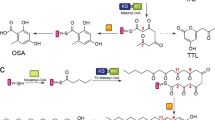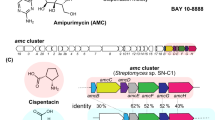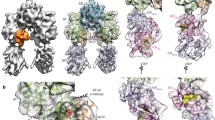Abstract
Type III polyketide synthases (PKSs) biosynthesize varied classes of metabolites with diverse bio-functionalities. Inherent promiscuous substrate specificity, multiple elongations of reaction intermediates and several modes of ring-closure, confer the proteins with the ability to generate unique scaffolds from limited substrate pools. Structural studies have identified crucial amino acid residues that dictate type III PKS functioning, though cyclization specific residues need further investigation. PKSIIINc, a functionally and structurally characterized type III PKS from the fungus, Neurospora crassa, is known to biosynthesize alkyl-resorcinol, alkyl-triketide- and alkyl-tetraketide-α-pyrone products. In this study, we attempted to identify residue positions governing cyclization specificity in PKSIIINc through comparative structural analysis. Structural comparisons with other type III PKSs revealed a motif with conserved hydroxyl/thiol groups that could dictate PKSIIINc catalysis. Site-directed mutagenesis of Cys120 and Ser186 to Ser and Cys, respectively, altered product profiles of mutant proteins. While both C120S and S186C proteins retained wild-type PKSIIINc product activity, S186C favoured lactonization and yielded higher amounts of the α-pyrone products. Notably, C120S gained new cyclization capability and biosynthesized acyl-phloroglucinol in addition to wild-type PKSIIINc products. Generation of alkyl-resorcinol and acyl-phloroglucinol by a single protein is a unique observation in fungal type III PKS family. Mutation of Cys120 to bulky Phe side-chain abrogated formation of tetraketide products and adversely affected overall protein stability as revealed by molecular dynamics simulation studies. Our investigations identify residue positions governing cyclization programming in PKSIIINc protein and provide insights on how subtle variations in protein cores dictate product profiles in type III PKS family.




Similar content being viewed by others
References
Bond C, Tang Y, Li L (2016) Saccharomyces cerevisiae as a tool for mining, studying and engineering fungal polyketide synthases. Fungal Genet Biol 89:52–61. https://doi.org/10.1016/j.fgb.2016.01.005
Chakrabortti A, Li J, Liang Z-X (2016) Complete genome sequence of the filamentous fungus Aspergillus westerdijkiae reveals the putative biosynthetic gene cluster of ochratoxin A. Genome Announcements 4:e00982-00916. https://doi.org/10.1186/s12864-016-2974-x
van der Lee TA, Medema MH (2016) Computational strategies for genome-based natural product discovery and engineering in fungi. Fungal Genet Biol 89:29–36. https://doi.org/10.1016/j.fgb.2016.01.012
Noar RD, Daub ME (2016) Bioinformatics prediction of polyketide synthase gene clusters from Mycosphaerella fijiensis. PLoS One 11:e0158471. https://doi.org/10.1371/journal.pone.0158471
Sharma KK (2016) Fungal genome sequencing: basic biology to biotechnology. Crit Rev Biotechnol 36:743–759. https://doi.org/10.3109/07388551.2015.1015959
Aylward J, Steenkamp ET, Dreyer LL, Roets F, Wingfield BD, Wingfield MJ (2017) A plant pathology perspective of fungal genome sequencing. IMA fungus 8:1–45. https://doi.org/10.5598/imafungus.2017.08.02.04
Möller M, Stukenbrock EH (2017) Evolution and genome architecture in fungal plant pathogens. Nat Rev Microbiol 15:756. https://doi.org/10.1038/nrmicro.2017.76
Bertrand RL, Abdel-Hameed M, Sorensen JL (2018) Lichen biosynthetic gene clusters. Part I. Genome sequencing reveals a rich biosynthetic potential. J Nat Prod. https://doi.org/10.1021/acs.jnatprod.7b00769
Li L, Tang M-C, Tang S, Gao S, Soliman S, Hang L, Xu W, Ye T, Watanabe K, Tang Y (2018) Genome mining and assembly-line biosynthesis of the UCS1025A pyrrolizidinone family of fungal alkaloids. J Am Chem Soc 140:2067–2071. https://doi.org/10.1021/jacs.8b00056
Chen H, Du L (2016) Iterative polyketide biosynthesis by modular polyketide synthases in bacteria. Appl Microbiol Biotechnol 100:541–557. https://doi.org/10.1007/s00253-015-7093-0
Itoh H, Miura A, Matsui M, Arazoe T, Nishida K, Kumagai T, Arita M, Tamano K, Machida M, Shibata T (2018) Knockout of the SREBP system increases production of the polyketide FR901512 in filamentous fungal sp. No. 14919 and lovastatin in Aspergillus terreus ATCC20542. Appl Microbiol Biotechnol 102:1393–1405. https://doi.org/10.1007/s00253-017-8685-7
Ruocco M, Baroncelli R, Cacciola SO, Pane C, Monti MM, Firrao G, Vergara M, di San Lio GM, Vannacci G, Scala F (2018) Polyketide synthases of Diaporthe helianthi and involvement of DhPKS1 in virulence on sunflower. BMC Genom 19:27. https://doi.org/10.1186/s12864-017-4405-z
Jackson SA, Crossman L, Almeida EL, Margassery LM, Kennedy J, Dobson AD (2018) Diverse and abundant secondary metabolism biosynthetic gene clusters in the genomes of marine sponge derived Streptomyces spp. Isolates. Mar Drugs 16:67. https://doi.org/10.3390/md16020067
Chen X, Xu M, Feng C, Hu C (2018) Progress in fungal polyketide biosynthesis. Chin J Biotechnol 34:151–164. https://doi.org/10.13345/j.cjb.170219
Wu C, Ichinose K, Choi YH, van Wezel GP (2017) Aromatic polyketide GTRI-02 is a previously unidentified product of the act gene cluster in streptomyces coelicolor A3 (2). ChemBioChem 18:1428–1434. https://doi.org/10.1002/cbic.201700107
Zhang Z, Pan H-X, Tang G-L (2017) New insights into bacterial type II polyketide biosynthesis. F1000Research. https://doi.org/10.12688/f1000research.10466.1
Shimizu Y, Ogata H, Goto S (2017) Type III polyketide synthases: functional classification and phylogenomics. ChemBioChem 18:50–65. https://doi.org/10.1002/cbic.201600522
Lim YP, Go MK, Yew WS (2016) Exploiting the biosynthetic potential of type III polyketide synthases. Molecules 21:806. https://doi.org/10.3390/molecules21060806
Yu H-N, Liu X-Y, Gao S, Sun B, Zheng H-B, Ji M, Cheng A-X, Lou H-X (2018) Structural and biochemical characterization of the plant type III polyketide synthases of the liverwort Marchantia paleacea. Plant Physiol Biochem 125:95–105. https://doi.org/10.1016/j.plaphy.2018.01.030
Kontturi J, Osama R, Deng X, Bashandy H, Albert VA, Teeri TH (2017) Functional characterization and expression of GASCL1 and GASCL2, two anther-specific chalcone synthase like enzymes from Gerbera hybrida. Phytochemistry 134:38–45. https://doi.org/10.1016/j.phytochem.2016.11.002
Xie L, Liu P, Zhu Z, Zhang S, Zhang S, Li F, Zhang H, Li G, Wei Y, Sun R (2016) Phylogeny and expression analyses reveal important roles for plant PKS III family during the conquest of land by plants and angiosperm diversification. Front Plant Sci 7:1312. https://doi.org/10.3389/fpls.2016.01312
Taura F, Iijima M, Yamanaka E, Takahashi H, Kenmoku H, Saeki H, Morimoto S, Asakawa Y, Kurosaki F, Morita H (2016) A novel class of plant type III polyketide synthase involved in orsellinic acid biosynthesis from Rhododendron dauricum. Front Plant Sci 7:1452. https://doi.org/10.3389/fpls.2016.01452
Zhou W, Zhuang Y, Bai Y, Bi H, Liu T, Ma Y (2016) Biosynthesis of phlorisovalerophenone and 4-hydroxy-6-isobutyl-2-pyrone in Escherichia coli from glucose. Microb Cell Fact 15:149. https://doi.org/10.1186/s12934-016-0549-9
Hashimoto M, Koen T, Takahashi H, Suda C, Kitamoto K, Fujii I (2014) Aspergillus oryzae CsyB catalyzes the condensation of two β-ketoacyl-CoAs to form 3-acetyl-4-hydroxy-6-alkyl-α-pyrone. J Biol Chem 289:19976–19984. https://doi.org/10.1074/jbc.m114.569095
Matsui T, Kodama T, Mori T, Tadakoshi T, Noguchi H, Abe I, Morita H (2017) 2-Alkylquinolone alkaloid biosynthesis in the medicinal plant Evodia rutaecarpa involves collaboration of two novel type III polyketide synthases. J Biol Chem 292:9117–9135. https://doi.org/10.1074/jbc.m117.778977
Sun W, Meng X, Liang L, Jiang W, Huang Y, He J, Hu H, Almqvist J, Gao X, Wang L (2015) Molecular and biochemical analysis of chalcone synthase from Freesia hybrid in flavonoid biosynthetic pathway. PLoS One 10:e011905. https://doi.org/10.1371/journal.pone.0119054
Meslet-Cladière L, Delage L, Leroux CJ-J, Goulitquer S, Leblanc C, Creis E, Gall EA, Stiger-Pouvreau V, Czjzek M, Potin P (2013) Structure/function analysis of a type III polyketide synthase in the brown alga Ectocarpus siliculosus reveals a biochemical pathway in phlorotannin monomer biosynthesis. Plant Cell 25:3089–3103. https://doi.org/10.1105/tpc.113.111336
Sone Y, Nakamura S, Sasaki M, Hasebe F, Kim S-Y, Funa N (2018) Identification and characterization of bacterial enzymes catalyzing the synthesis of 1, 8-dihydroxynaphthalene, a key precursor of dihydroxynaphthalene melanin, from Sorangium cellulosum. Appl Environ Microbiol: AEM. https://doi.org/10.1128/aem.00258-18
Li L, Aslam M, Rabbi F, Vanderwel MC, Ashton NW, Suh D-Y (2018) PpORS, an ancient type III polyketide synthase, is required for integrity of leaf cuticle and resistance to dehydration in the moss, Physcomitrella patens. Planta 247:527–541. https://doi.org/10.1007/s00425-017-2806-5
Hou L, Huang H, Li H, Wang S, Ju J, Li W (2018) Overexpression of a type III PKS gene affording novel violapyrones with enhanced anti-influenza A virus activity. Microb Cell Fact 17:61. https://doi.org/10.1186/s12934-018-0908-9
von Wettstein-Knowles P (2017) The polyketide components of waxes and the Cer-cqu gene cluster encoding a novel polyketide synthase, the β-diketone synthase, DKS. Plants 6:28. https://doi.org/10.3390/plants6030028
Quadri LE (2014) Biosynthesis of mycobacterial lipids by polyketide synthases and beyond. Crit Rev Biochem Mol Biol 49:179–211. https://doi.org/10.3109/10409238.2014.896859
Shen Y, Li X, Chai T, Wang H (2016) Outer-sphere residues influence the catalytic activity of a chalcone synthase from Polygonum cuspidatum. FEBS Open Biol 6:610–618. https://doi.org/10.1002/2211-5463.12072
Raja Abdul Rahman RNZ, Zakaria II, Salleh AB, Basri M (2012) Enzymatic properties and mutational studies of chalcone synthase from physcomitrella patens. Int J Mol Sci 13:9673–9691. https://doi.org/10.3390/ijms13089673
Jez JM, Austin MB, Ferrer J-L, Bowman ME, Schröder J, Noel JP (2000) Structural control of polyketide formation in plant-specific polyketide synthases. Chem Biol 7:919–930. https://doi.org/10.1016/S1074-5521(00)00041-7
Austin MB, Bowman ME, Ferrer J-L, Schröder J, Noel JP (2004) An aldol switch discovered in stilbene synthases mediates cyclization specificity of type III polyketide synthases. Chem Biol 11:1179–1194. https://doi.org/10.1016/j.chembiol.2004.05.024
Satou R, Miyanaga A, Ozawa H, Funa N, Katsuyama Y, K-i Miyazono, Tanokura M, Ohnishi Y, Horinouchi S (2013) Structural basis for cyclization specificity of two azotobacter type III polyketide synthases a single amino acid substitution reverses their cyclization specificity. J Biol Chem 288:34146–34157. https://doi.org/10.1074/jbc.m113.487272
Goyal A, Saxena P, Rahman A, Singh PK, Kasbekar DP, Gokhale RS, Sankaranarayanan R (2008) Structural insights into biosynthesis of resorcinolic lipids by a type III polyketide synthase in Neurospora crassa. J Struct Biol 162:411–421. https://doi.org/10.1016/j.jsb.2008.02.009
Hashimoto M, Nonaka T, Fujii I (2014) Fungal type III polyketide synthases. Nat Prod Rep 31:1306–1317. https://doi.org/10.1039/c4np00096j
Sankaranarayanan R, Saxena P, Marathe UB, Gokhale RS, Shanmugam VM, Rukmini R (2004) A novel tunnel in mycobacterial type III polyketide synthase reveals the structural basis for generating diverse metabolites. Nat Struct Mol Biol 11:894–900. https://doi.org/10.1038/nsmb809
Ferrer J-L, Jez JM, Bowman ME, Dixon RA, Noel JP (1999) Structure of chalcone synthase and the molecular basis of plant polyketide biosynthesis. Nat Struct Mol Biol 6:775. https://doi.org/10.1038/11553
Funa N, Ozawa H, Hirata A, Horinouchi S (2006) Phenolic lipid synthesis by type III polyketide synthases is essential for cyst formation in Azotobacter vinelandii. Proc Natl Acad Sci 103:6356–6361. https://doi.org/10.1073/pnas.0511227103
Austin MB, Izumikawa M, Bowman ME, Udwary DW, Ferrer J-L, Moore BS, Noel JP (2004) Crystal structure of a bacterial type III polyketide synthase and enzymatic control of reactive polyketide intermediates. J Biol Chem 279:45162–45174. https://doi.org/10.1074/jbc.m406567200
Funa N, Ohnishi Y, Ebizuka Y, Horinouchi S (2002) Properties and substrate specificity of RppA, a chalcone synthase-related polyketide synthase in Streptomyces griseus. J Biol Chem 277:4628–4635. https://doi.org/10.1074/jbc.m110357200
Rubin-Pitel SB, Zhang H, Vu T, Brunzelle JS, Zhao H, Nair SK (2008) Distinct structural elements dictate the specificity of the type III pentaketide synthase from Neurospora crassa. Chem Biol 15:1079–1090. https://doi.org/10.1016/j.chembiol.2008.08.011
Acknowledgements
P.S. gratefully acknowledges Innovative Young Biotechnologist Award (IYBA) of Department of Biotechnology (DBT), Ministry of Science and Technology, Government of India and South Asian University (SAU) Startup Research Grant, SAU, India for providing funds and support for this study. A.P. acknowledges CSIR for Senior Research Fellowship. We are thankful to Dr. Rajesh S. Gokhale (NII, India) for kindly providing the pET28c-PKSIIINc recombinant expression plasmid. We thank Sciex, Gurugram, India for Mass Spectrometry data collection.
Author information
Authors and Affiliations
Corresponding author
Ethics declarations
Conflict of interest
The authors declare that they have no conflict of interest.
Electronic supplementary material
Below is the link to the electronic supplementary material.
Rights and permissions
About this article
Cite this article
Parvez, A., Giri, S., Bisht, R. et al. New Insights on Cyclization Specificity of Fungal Type III Polyketide Synthase, PKSIIINc in Neurospora crassa. Indian J Microbiol 58, 268–277 (2018). https://doi.org/10.1007/s12088-018-0738-9
Received:
Accepted:
Published:
Issue Date:
DOI: https://doi.org/10.1007/s12088-018-0738-9




